CACAO TREE AND FRUIT
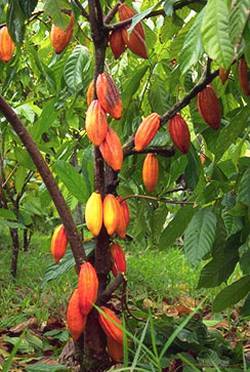
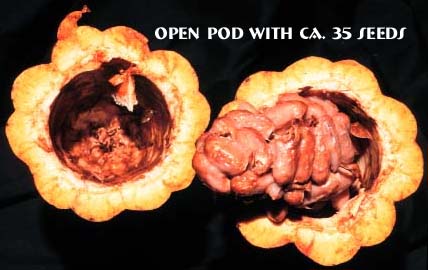
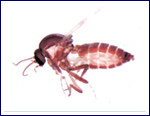 midge fly
midge fly
Description Of the Cacao Plant
The cocoa tree takes five years to grow into a tree that gives fruit. Cocoa trees grow to a height of 50 feet but, to make harvesting easier, they are usually pruned back to a height of 20 feet. They are in leaf continuously; blossom, unripe fruit and also mature fruit can be seen on the branches at the same time. The leaves are long and slender and grow separated on the branches. It has fragile branches that are not able hold the weight of the fruit.
The first blossoms begin to appear after about two years—delicate pink and yellowish-white blossom petals. The blossoms sit right on the trunk of the tree. They look like orchids. When cacao leaves fall, they mix with the leaves of other plants and decay on the forest floor. In the decaying leaves breed midges, the little flies that pollinate cacao flowers. Without these little flies the flower would not be pollinated to form fruit.
Unlike most fruit that grows on the branches, cacao pods
grow directly on the trunk of the tree. They give fruit three to four times a year.
The hard, coarse
shell changes from green to yellow, and then to a reddish brown. Inside the
fruit is a white sweet pulp and arranged in five rows are between 20 and 40
almond-shaped bitter cocoa seeds. These seeds are the ones used to make
chocolate.
Unlike many other plants, the cacao tree has no way to release its own seeds and must rely on animals to do the work. The pods’ skins are so thick that they do not open naturally to release their seeds. Instead, pods rely on the lure of their sweet pulp to attract animals. Birds and mammals looking for a quick meal pierce the pod’s tough hide to get at the delicious sweet pulp inside and discard the bitter-tasting seeds.
The cacao tree can flourish only in the hottest regions of the world, but the young plants in particular need lots of shade. Delicate seedlings are easily sunburned, and so they must have direct cover from larger trees in the rainforest canopy. The cocoa trees develops under the shade of other large tropical forest trees. In farms they may be under or banana or coconut trees. They need 80+ inches of rain, and high humidity.
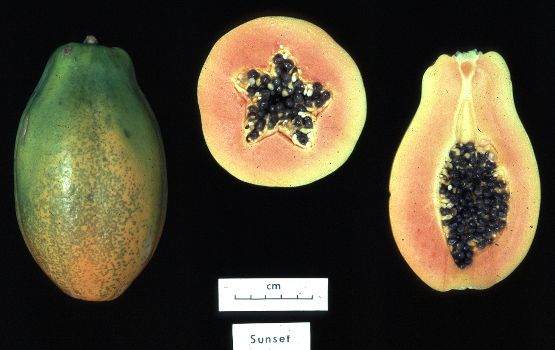
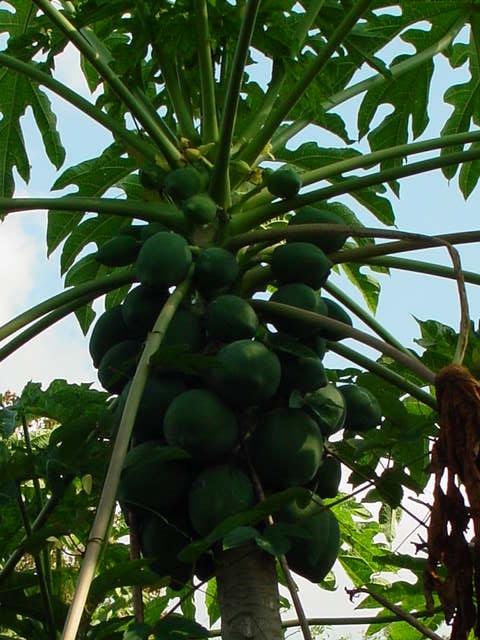
 fruit fly
fruit fly
Description of the Papaya Plant
The papaya is a short-lived, fast-growing, woody, large plant that grows to 10 or 12 feet in height. All parts contain latex. The hollow green or deep purple trunk is straight and cylindrical with prominent leaf. The leaves grow from the upper part of the stem in a spiral. The blade, deeply divided into 5 to 9 main segments, varies from 1 to 2 feet in width, and has yellowish and veins. The life of a leaf is 4 to 6 months.
The five-petal flowers are fleshy, waxy and slightly fragrant. How pollination takes place in papayas is not known for sure. Wind is probably the main agent, as the pollen is light and abundant, but thrips and moths may help. Hand pollination is sometimes necessary to get a proper fruit set.
There are two types of papayas, Hawaiian and Mexican. The Hawaiian varieties are the papayas commonly found in supermarkets. These pear-shaped fruit generally weigh about 1 pound and have yellow skin when ripe. The flesh or pulp is bright orange or pinkish, with small black seeds clustered in the center. Hawaiian papayas are easier to harvest because the plants seldom grow taller than 8 feet. Mexican papayas are much larger the the Hawaiian types and may weigh up to 10 pounds and be more than 15 inches long. The flesh or pulp may be yellow, orange or pink. The flavor is less intense than that the Hawaiian papaya but still is delicious and extremely enjoyable. They are slightly easier to grow than Hawaiian papayas. A properly ripened papaya is juicy, sweetish and somewhat like a cantaloupe in flavor, although musky in some types. The fruit contain papain which helps digestion and is used to tenderize meat. The edible seeds have a spicy flavor somewhat reminiscent of black pepper.
Papayas like to be warm with both sunshine and reflected heat, so the hottest place against the house where nothing else seems happy is an ideal location. They also like to be as free from wind as possible, although this is not as critical as their need for sun. Papayas can be grown successfully in shade, but the fruit is rarely sweet. Papayas need light, well-drained soil. They are easily killed by excess moisture. The soil needs to be moist in hot weather and dry in cold weather. Another enemy of the papaya is the fruit fly. The fruit fly will infect the fruit and kill it.